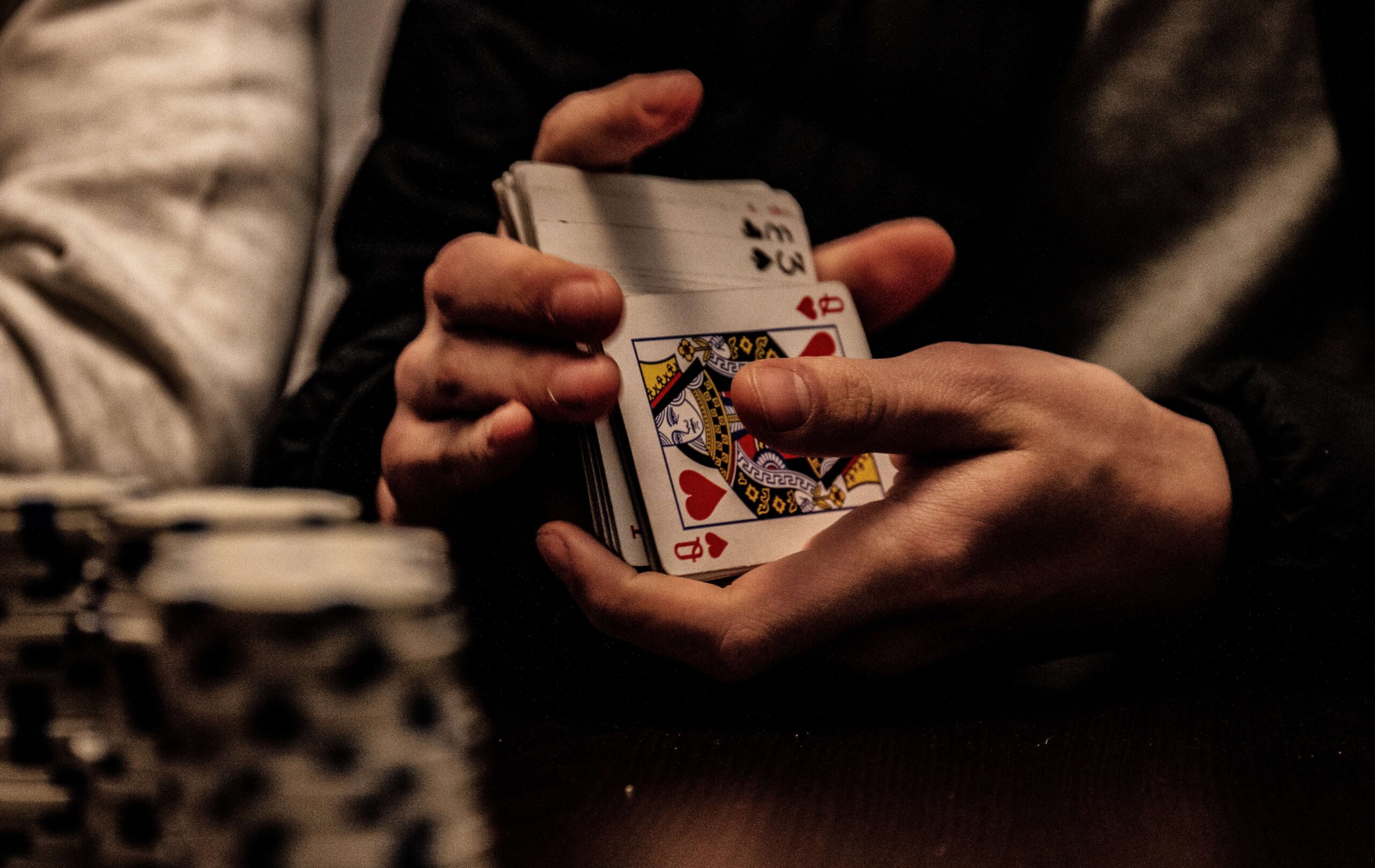An ante in poker is a small, mandatory bet that all players are required to contribute to the pot before the start of each hand. The ante helps seed the pot and encourages action, as money is already in play before the players receive their cards. Antes are commonly used in poker tournaments and some cash games, particularly in Stud and Draw variants. The word “ante” comes from Latin and means “before.” We now know that the ante is made before the cards are dealt hence the name.
The primary purpose of the ante is to create a minimum pot size, which incentivizes players to participate in the hand and compete for the money in the pot. Antes increase as the game or tournament progresses, ensuring that the pot sizes grow and pressure mounts on the players.
In some poker games and tournaments, antes are used alongside blinds, which are also forced bets but only posted by the two players to the left of the dealer. While blinds rotate around the table as the dealer button moves, antes are posted by every player in the hand, making the overall pot size larger.
In all forms of poker, it is required that all players contribute a certain amount of money to the pot before the cards are dealt. This mandatory bet, called the ante, is equal for all players at the table. The primary objective of placing an ante in poker games is to encourage all players to participate in the game, rather than waiting for a strong hand to make a bet.
Without an ante, conservative or tight players may not take part in the game at all unless they have a powerful hand, such as pocket aces or pocket kings. Therefore, the significance of the ante in poker is to initiate action in any game of poker. In poker, an ante is placed by all players contributing an equal number of chips or money to the pot before the cards are dealt. The ante can either be a fixed amount or the smallest denomination in play. For those interested in further investigating the various rules of poker, head to https://analyzepoker.nz/.
How to Play Ante in Poker
If you’re new to poker, “anteing up” may initially seem confusing. But it is, in fact, quite simple. Here’s how to play ante in poker:
- First, everyone at the table must agree on the size of the ante. This can be any amount but is typically a small fraction of the big blind (the minimum bet). So, if the big blind is $10, the ante might be $1.
- Once the ante has been agreed upon, every player must place that amount into the pot before any cards are dealt. The player to the left of the dealer then starts the betting round.
- After each player has had a turn to bet or fold, the next card is dealt face-up in the center of the table. Another round of betting follows this. And so on until all players have 2-hole cards and five community cards (the board).
- At this point, whoever has the best 5-card hand wins the pot!
When would there be no Antes?
For some variants of poker, like Omaha or Razz, antes aren’t used since they have only blinds or bring-in bets to seed the pot. The same applies to most gash games where players buy in with a specific amount of money and can rebuy or leave the table anytime. For some informal, beginner, or low-stakes home games, antes may not be used in order to keep the game simple or the pot sizes small. Finally, for some poker tournaments, antes are not introduced until the later stages or may not be used at all. This decision depends on the specific tournament format and structure.
Pros and Cons of Playing Ante in Poker
When it comes to playing with ante in poker, there are pros and cons that should be considered. For some players, the pros of playing with ante outweigh the cons; for others, it’s the opposite. Ultimately, it’s up to each individual player to decide whether or not playing with ante is right for them.
The most significant pro of playing ante is that it can help seed the pot since each player is forced to add to it before every hand even begins. Doing so can be beneficial for several reasons, such as incentivizing players to stay in hands and better opportunities to win big pots. However, there are also a few potential drawbacks to playing with antes. One is that it can increase the amount of “dead money” in the pot since players who fold early on will still have to seed the pot that they won’t have a chance to win back. Additionally, playing with ante can make it more challenging to play tight/aggressive poker styles, as there’s already money in the pot that must be defended.
Alternatives to Playing Ante
There are a few alternatives to playing with antes in poker. One option is to have the two blinds (small blind and big blind). This is commonly done in short-handed games (six players or less). Another option is to play pot-limit or no-limit, eliminating the need for an ante altogether. Finally, some people prefer a “bring-in” bet over an ante; and is often used in stud games.
Ante is an Important Part of the Game
To summarize, the ante is an essential part of poker that all players must understand. Antes add money to the pot before any cards are dealt, allowing players to win bigger pots during each hand. Furthermore, even if you fold your hand early on in the game, you can still recoup some of your lost investment if you have placed an ante before the beginning of a round. Finally, antes can be an excellent way for new or inexperienced players to get familiar with the betting process and practice their strategies with smaller stakes.
What About a Big Blind Ante?
The big blind ante is a game mechanism in poker that has gained popularity in recent years. It is particularly favoured in tournaments because it simplifies and speeds up the game, allowing more hands to be played in a shorter amount of time.
In traditional poker games, each player is required to pay an ante fee before every hand. This fee is usually a small percentage of the minimum bet, and it can quickly add up to a substantial amount of money over time. Moreover, players often forget to post their antes, which slows the game down as the dealer has to remind them repeatedly.
The big blind ante solves these problems by assigning the responsibility of paying the ante to the player in the big blind position. This player pays a pre-determined amount that is equal to the sum of all the antes that would have been paid by individual players. As a result, the game becomes more efficient, and players can focus on the actual gameplay instead of worrying about posting their ante.
One significant advantage of the big blind ante is that it incentivizes players to play more aggressively. Since the big blind now has to pay the ante for everyone, it becomes more fun to steal the blinds by making a bigger bet. This not only adds excitement to the game but also speeds up the action, as players are more likely to fold rather than call a larger bet.
In summary, the big blind ante is a significant development in the world of poker that has helped to streamline the game and make it more enjoyable for players. Its adoption in tournaments and other high-stakes games has been rapid, and it is likely to become even more widespread in the future.
This is Why You Should Use a Big Blind Ante
The big blind ante has become a popular format in poker tournaments due to its ability to speed up the game while maintaining fairness among players. In traditional ante formats, every player at the table is required to pay an ante, which can slow down the game as the dealer needs to ensure that everyone pays the correct amount. Additionally, players may forget to post their antes, leading to disputes and delays in the game.
With the big blind ante format, the player in the big blind position pays the ante for every player at the table. This simplifies the process and eliminates disputes regarding the payment of ante bets. The big blind ante also has the benefit of increasing the pot size, making it more attractive for players to try to steal the blinds.
Moreover, since only the player in the big blind position pays the ante, this eliminates any advantage that might have been gained from players choosing to sit in certain positions around the table. This ensures that all players interacting in a dynamic way, ensuring fun for all.
In Summary…
In poker, the ante is a mandatory bet that all players must contribute before the cards are dealt. The purpose of the ante is to encourage players to participate in the game, rather than waiting for a strong hand to make a bet. With the big blind ante format, the player in the big blind position pays the ante for every player at the table, eliminating disputes and speeding up the game. This format also incentivizes players to play more aggressively, making it more fun and exciting for everyone involved. Furthermore, the big blind ante ensures fairness among players, eliminating any advantage that might have been gained from players choosing to sit in certain positions around the table. Overall, the big blind ante is a significant development that has helped to streamline the game and make it more enjoyable for players, and it is likely to become even more widespread in the future.






